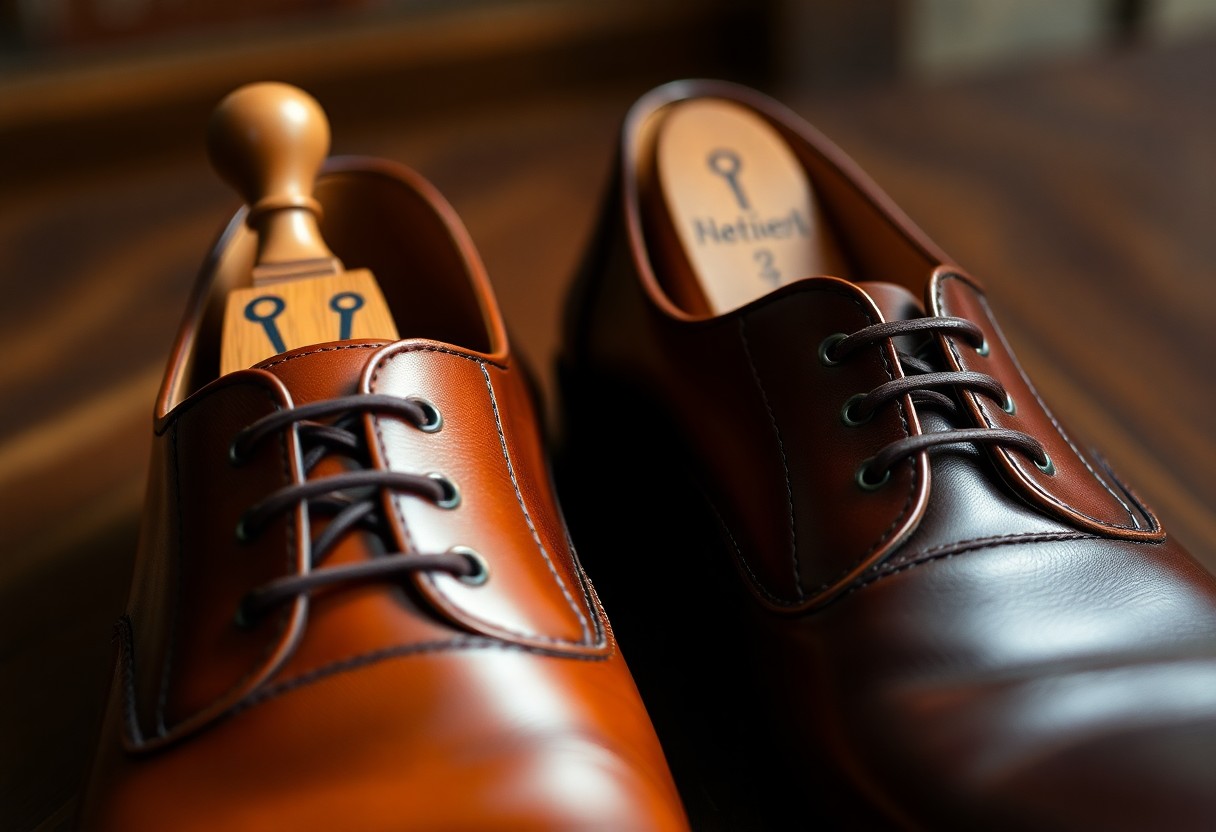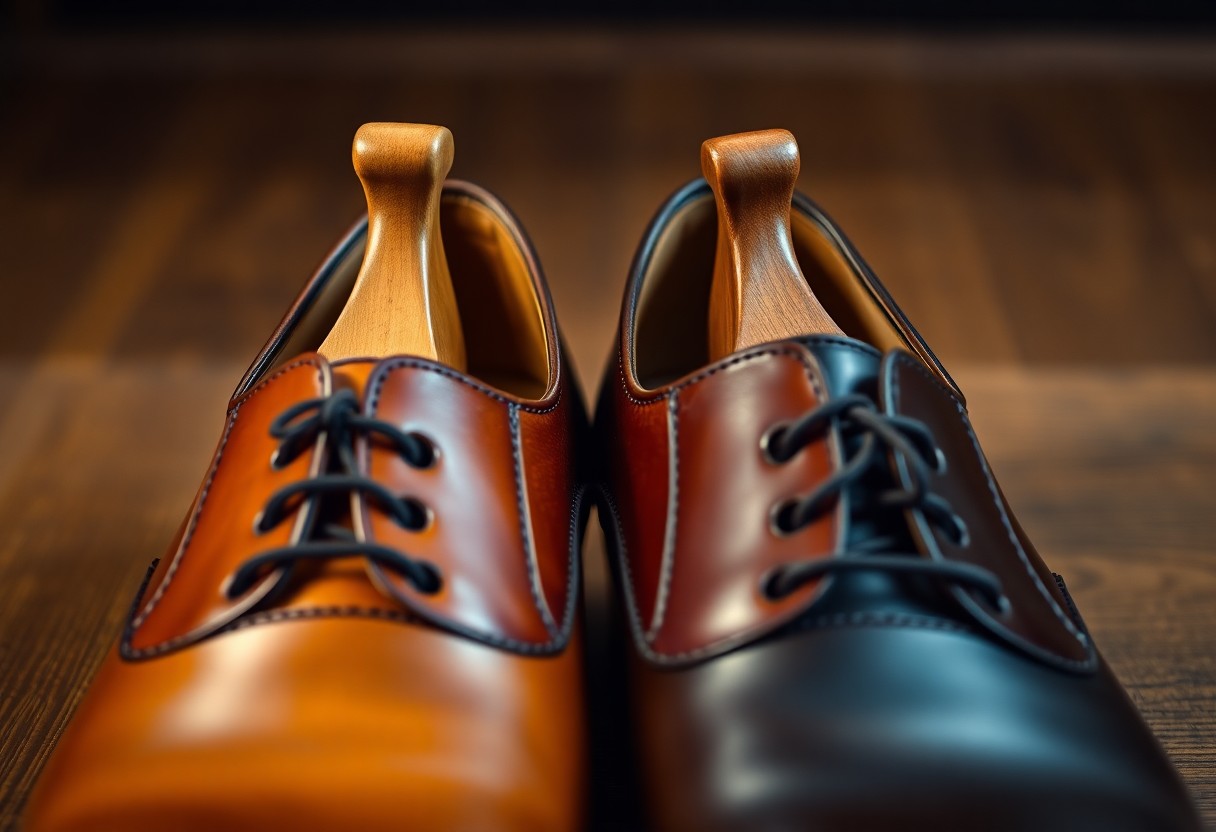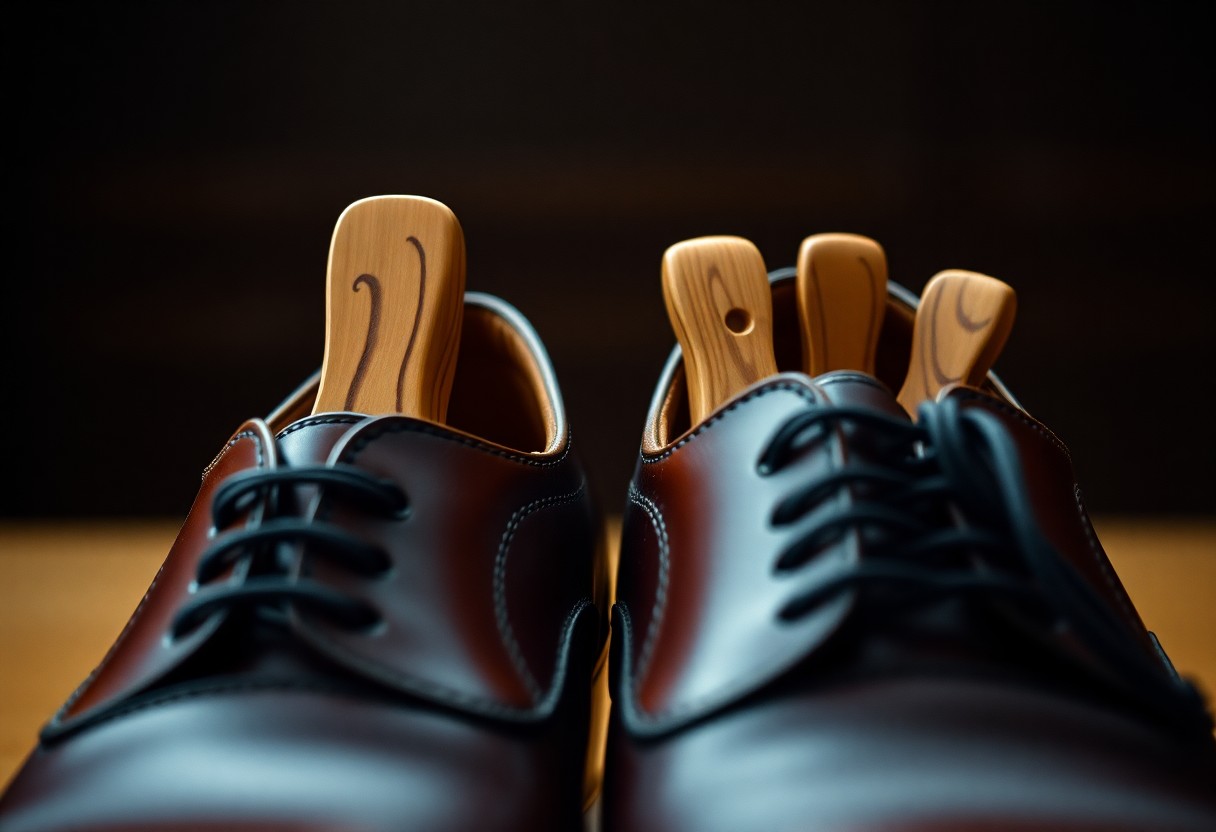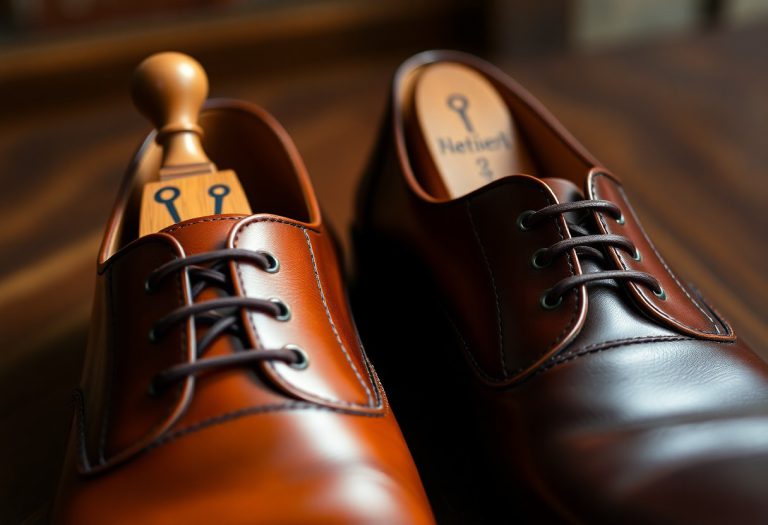Many shoe enthusiasts may not realize that utilizing low-quality shoe trees can lead to significant damage to their premium footwear. Understanding the importance of investing in high-quality shoe trees is crucial as they can extend the lifespan of your cherished shoes by as much as 300%. These superior shoe trees play a vital role in safeguarding your footwear by effectively absorbing moisture, preserving the shoe’s shape, and preventing unsightly creases that can detract from the aesthetic appeal of leather. While cheaper alternatives might initially seem economical, they can result in irreversible deformation and structural issues over time. Opting for high-quality shoe trees is essential for maintaining the form and durability of your footwear, ensuring they remain in excellent condition for years to come.
Uncovering the Hidden Costs of Selecting Inexpensive Shoe Trees
When you invest in high-quality footwear, pairing that investment with the right shoe trees is equally important. While cheaper alternatives may appear appealing, they can ultimately result in damage that costs between $300 and $500 to repair on your premium shoes. Typically, quality shoe trees are priced only $30 to $50 more than their budget counterparts, yet they provide superior moisture absorption and help your shoes maintain their shape for years to come. The long-term benefits of investing in quality shoe trees significantly outweigh the initial expense, making them a wise choice for any serious shoe collector aiming to protect their investment.
Identifying Common Design Flaws in Budget Shoe Trees
Upon closer examination, it becomes evident that inexpensive shoe trees often exhibit several design flaws that can undermine their effectiveness. For instance, you might encounter excessive spring tension that warps the leather, poorly shaped toe boxes that fail to conform to natural foot contours, and low-quality wood that doesn’t effectively absorb moisture. These fundamental design shortcomings render inexpensive shoe trees ineffective at protecting your valuable footwear. By recognizing these deficiencies, you can make more informed choices when selecting shoe trees that will genuinely safeguard your cherished shoes from potential damage.
Assessing the Potential Risks to Your Quality Footwear
The most alarming risk associated with cheap shoe trees is the potential for permanent damage to your beloved shoes. Over time, your footwear may suffer from misshapen toe boxes, stretched vamps, and deformed heel counters. Such structural issues not only shorten the lifespan of your shoes but also significantly diminish their overall value. A thorough inspection of shoes affected by low-quality trees often reveals damage that extends beyond mere cosmetic concerns, showcasing uneven wear patterns, compromised leather quality, and inadequate moisture protection. The spring mechanisms in cheaper shoe trees can create pressure points that permanently alter the structure of your shoes, leading to discomfort and decreased durability.

Key Features to Seek Out in Quality Shoe Trees
When selecting shoe trees for your footwear, it’s crucial to focus on features that will effectively protect and maintain the shape of your shoes. Quality shoe trees distribute pressure evenly across the entire shoe, contrasting with cheaper options that may inflict damage through excessive force. Premium shoe trees typically come with adjustable width settings and robust heel support, making them an invaluable investment for any serious shoe owner. Understanding these essential features is vital to selecting shoe trees that will faithfully serve your footwear over time, ensuring they remain in optimal condition.
Critical Construction Elements for Ensured Durability
When evaluating high-quality shoe trees, several key components stand out. The split-toe mechanism should operate smoothly, allowing for gentle expansion without imposing undue stress on the leather. Your ideal shoe tree should include a well-formed heel block to maintain the shape of the heel counter and a forefoot design that aligns with the natural contours of the foot. These features work together to prevent creasing and preserve the structural integrity of your shoes, ensuring they remain in excellent condition for many years to come.
Material Selections for Optimal Performance and Longevity
The materials used in constructing a shoe tree are pivotal to its effectiveness. Cedar wood is widely recognized as the premier choice due to its natural moisture-absorbing properties and pleasant aromatic qualities. Cedar not only aids in combating unpleasant odors but also creates a healthy internal environment for your shoes. It’s advisable to avoid plastic alternatives, as they lack moisture-wicking capabilities and can trap dampness, leading to potential damage. Additionally, cedar wood is rich in natural oils that help maintain leather quality. This material can effectively regulate humidity levels, preventing deterioration of the leather. Quality shoe trees constructed from cedar can yield lasting benefits, making them a cost-effective investment for extending the lifespan of your footwear by as much as 30%.
Effective Strategies for Safeguarding Your Investment in Quality Footwear
Given the significant financial commitment involved in acquiring quality shoes, selecting the right shoe trees becomes crucial for safeguarding this investment. High-quality shoe trees can significantly extend your footwear’s life by as much as 15 to 20 years, while cheap alternatives may lead to damage costing hundreds of dollars. It’s essential that your premium footwear be paired with the appropriate care tools to maintain its value and appearance, ensuring that your investment remains protected over time and continues to serve you well.
Proven Strategies for Preserving Shoe Value
The journey of protecting your shoes begins with selecting the right shoe trees. Poor-quality trees can easily deform high-end shoes, particularly in critical areas such as the heel counter and vamp. Investing in quality shoe trees, typically falling within the $50 to $80 price range, is a proactive measure to preserve the original shape of your footwear and can prevent costly repairs or replacements in the future. By prioritizing quality, you can significantly enhance both the longevity and visual appeal of your shoes, ensuring they remain in pristine condition for years.
Benefits of Longevity Through Quality Shoe Trees
Utilizing high-quality shoe trees ensures optimal moisture absorption and shape retention. Cedar wood shoe trees can absorb up to 60% more moisture than less expensive plastic alternatives, allowing your shoes to dry naturally and maintain their structure between wears. Regularly using properly designed shoe trees is vital for preserving your footwear. Quality shoe trees that feature a solid forefoot design and balanced spring tension will prevent deep creases from forming in the leather, which can lead to cracks and irreversible damage. With the right support from shoe trees, your shoes will retain their original shape and comfort for many years, contributing to their overall longevity.

Comprehensive Guidelines for Selecting the Ideal Shoe Trees
After reviewing various shoe tree options, finding the right balance between quality and functionality is paramount. A well-constructed shoe tree should completely fill your shoe’s toe box while providing gentle tension. Your selection will significantly impact how effectively your shoes retain their shape and absorb moisture after each wear, so invest the necessary time to make a well-informed choice that aligns with your footwear needs.
Size and Fit Considerations for Optimal Shoe Tree Performance
Your shoe trees must be perfectly matched to your shoe size—resist the temptation to choose a size up or down. An incorrectly sized shoe tree can damage your footwear by exerting excessive pressure or failing to provide adequate support. The shoe trees should slide in effortlessly, filling approximately 90% of your shoe’s internal volume to ensure effective moisture control and optimal shape maintenance, preventing any potential issues that could arise from poor fit.
Trusted Brands for Assurance of Quality Shoe Trees
To guarantee the best protection for your investment, select shoe trees from reputable manufacturers such as Woodlore, Rochester, or Stratton. These brands are renowned for their cedar construction and properly designed spring mechanisms that will not compromise your shoes. When considering long-term value, investing in quality shoe trees from trusted brands can save you money by extending the lifespan of your footwear by 15-20%. Look for desirable features such as split-toe designs and adequate heel support, while avoiding plastic options or models with aggressive spring mechanisms that may deform your footwear.
Successful Techniques for Proper Shoe Tree Usage
Unlike basic shoe storage methods, effective shoe tree usage requires meticulous attention to detail and precise placement. It is essential to insert your shoe trees immediately after wearing your shoes to maintain their shape and absorb moisture effectively. Your shoe trees should provide firm yet gentle support, ensuring that the front section fills the toe box, and that the heel area is aligned correctly to avoid any structural deformities.
Step-by-Step Techniques for Correct Shoe Tree Insertion
When inserting the shoe tree, start with the toe section, angling it downward into the shoe gently. Slightly compress the spring mechanism and carefully guide the heel section into place. The shoe tree should fit snugly without creating excessive pressure that could stretch the leather beyond its natural limits, ensuring a secure fit that maintains the shoe’s integrity.
Vital Maintenance Tips for Prolonged Shoe Tree Longevity
To maximize the lifespan of your shoe trees, adhere to the following essential maintenance practices:
- Regular cleaning with a dry cloth to eliminate dust and debris, ensuring they remain in top condition.
- Monthly inspection of the spring mechanism for signs of wear, allowing for timely replacements if necessary.
- Refreshing cedar wood through light sanding to uphold its moisture-absorbing qualities, ensuring optimal performance.
- Storing in a dry location to prevent mold and degradation, preserving the integrity of the shoe trees.
Being proactive about monitoring signs of wear on your shoe trees can help prevent damage to your footwear, ultimately saving you money in the long run.
Moreover, implementing this additional care routine enhances the effectiveness of your shoe trees:
- Rotating usage among multiple pairs of shoes to distribute wear evenly, prolonging their lifespan.
- Checking ventilation in storage spaces to avoid excess moisture accumulation, protecting your shoes from potential damage.
- Assessing the surface integrity of your shoe trees regularly to ensure continuous performance.
- Monitoring moisture levels to guarantee optimal performance, preventing deterioration of your footwear.
Recognizing the importance of these practices ensures that your $50-$100 investment in quality shoe trees effectively protects your footwear and extends its life.
Evaluating Price versus Value in Shoe Trees
The initial cost difference between inexpensive and high-quality shoe trees may seem significant at first glance, but your investment plays a crucial role in the longevity of your shoes. While basic models may range from $10 to $15, premium shoe trees priced at $30 to $50 offer better protection and can ultimately save you money by preventing costly shoe repairs or replacements in the future.

Understanding the Long-Term Cost Benefits of Quality Shoe Trees
The math is straightforward: quality shoe trees can extend the life of your shoes by as much as 5 years. For instance, if you own a pair of $300 dress shoes, investing an additional $20 to $30 in high-quality shoe trees can lead to considerable savings over time, as low-quality trees can inflict significant damage that results in premature replacement costs.
Identifying Key Quality Indicators in Shoe Trees
For reliable performance from your shoe trees, look for solid cedar construction, a smooth finish to prevent snags, and balanced spring mechanisms that support your footwear without causing deformation. Additionally, ensure that the heel width is appropriate and that the toe box is well-shaped to match the natural contours of your shoes, ensuring a snug yet gentle fit.
Over time, the true value of quality shoe trees becomes evident. Features such as adjustable width controls, effective ventilation holes, and user-friendly knob handles indicate superior craftsmanship. Avoid shoe trees with excessive spring tension, as these can permanently deform your shoes and compromise their overall structural integrity, leading to potential damage.
Essential Takeaways on Investing in Quality Shoe Trees for Longevity
In summary, your choice of shoe trees directly influences the longevity and shape retention of your footwear. Quality shoe trees are vital for protecting your investment, as they help maintain the integrity of the leather and prevent permanent creases. By investing in well-designed shoe trees that offer balanced pressure distribution and robust construction, you will ultimately save money in the long run by prolonging the lifespan of your shoes. Quality shoe trees are indispensable for mitigating the deformation risks associated with cheaper alternatives, making them essential tools in your shoe care routine.
Your Most Frequently Asked Questions about Shoe Trees Answered
How do premium shoe trees provide superior protection for costly shoes compared to cheaper options?
Premium shoe trees are engineered with balanced pressure distribution and a shape that aligns with the natural contours of the foot. They effectively prevent deep creases in the leather from forming, absorb moisture efficiently, and maintain the original shape of the shoe. In contrast, inexpensive shoe trees often feature excessive spring tension that can lead to deformation, particularly in the vamp and heel areas. Quality shoe trees utilize superior materials like cedar and boast solid forefoot construction to safeguard the structure of your shoes.
What justifies the price difference between inexpensive and quality shoe trees as a worthwhile investment?
High-quality shoe trees serve as protectors for shoes that may cost hundreds or even thousands of dollars. While cheap options typically range from $10 to $20, premium shoe trees priced between $30 and $50 can last for many years, helping to prevent costly damage to your footwear. The minimal cost difference becomes negligible when compared to the potential for protecting valuable shoes from shape distortion, deep creases, and premature wear. Quality shoe trees ultimately contribute to prolonged shoe life and enhanced appearance.
What essential features should I prioritize when selecting high-quality shoe trees?
When shopping for effective shoe trees, prioritize solid wood construction, smooth finishes to avoid snags, and balanced spring tension for optimal support. Cedar wood is particularly advantageous due to its moisture-absorbing properties and ability to combat odors. The forefoot should be solid, not split, to provide better shape retention. Additionally, the heel should exert moderate tension to maintain shape without causing distortion, ensuring that the design mimics natural foot contours while accommodating various shoe styles.
The Article Why investing in quality shoe trees matters benefits of avoiding cheap options appeared first on My Shoes Finder
The Article Investing in Quality Shoe Trees: Avoid Cheap Options for Longevity Was Found On https://limitsofstrategy.com
References:
Investing in Quality Shoe Trees: Avoid Cheap Options for Longevity




